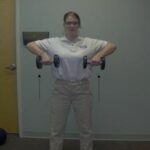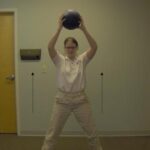I’m a certified personal trainer and have had some clients who suffered from chronic rotator cuff problems. Rotator cuff problems are extremely common, not just something that competitive athletes suffer from. Everyday motions can strain this joint. So don’t think it’s limited to baseball and tennis players or weight lifters.
The rotator cuff is a group of four muscles and their delicate tendons. These muscles enable the shoulder to move in different ways. Stand with your arms hanging straight at your sides. Now, slowly lift them up at your sides, keeping them straight, palms facing the floor. Keep shoulders relaxed. Do you feel pain or anything irksome in one or both shoulders? If so, chances are, this is a rotator cuff problem, mainly with the supraspinatus rotator cuff muscle.
There are other ways to test for a rotator cuff problem, but I won’t go into them here since they are tricky to describe. However, another classic sign is that when you reach up for something, like grabbing something off the top of the refrigerator or a high shelf, you feel an uncomfortable tweak, ache or pain in your shoulder.
If you lift weights, a rotator cuff problem will be obvious when you do the following routines: bench press, pushups, above-the-head shoulder presses, and sometimes, wide-grip pull-downs and dumbbell presses (depending on amount of weight).
Here are everyday movements that can cause, or aggravate, rotator cuff problems.
One: When you feed your arm into a coat arm or jacket arm, your palm faces the floor. The joint motions here are shoulder internal rotation, and shoulder abduction. These two joint motions in combination “crowd out” the air space at the rotator cuff, and can actually result in the humerus bone of the upper arm making contact with a rotator cuff tendon. Over time, the bone frays the edge of the tendon. To prevent this, when you feed your arm into an arm hole, do it with 1) your palm up, and 2) your arm as bent as you can. This creates an opening in the joint, which gives the humerus more room, and thus, it does not contact the tendon.
Two: When you reach for high objects, your palm is facing down. When you hold the object and lower your arm, your palm is facing down or sideways. Again, this palms-down motion crowds out the joint, bringing the humerus bone too close to the tendon. When you reach up for that jar of pickles or whatever, face the palm to the ceiling. After grabbing the jar or item, hold it with the palm facing the ceiling as you lower your arm. In other words, always have a palms-up approach.
Three: When draping a jacket or sweater over the passenger seat of the car when you’re driving, your palm is down. When reaching to the back seat to either place something there, or retrieve something, your palm is down. This is bad news. It crowds out that gleno-humeral space. Perform these actions with the PALM UP. And keep the arm bent as much as possible.



